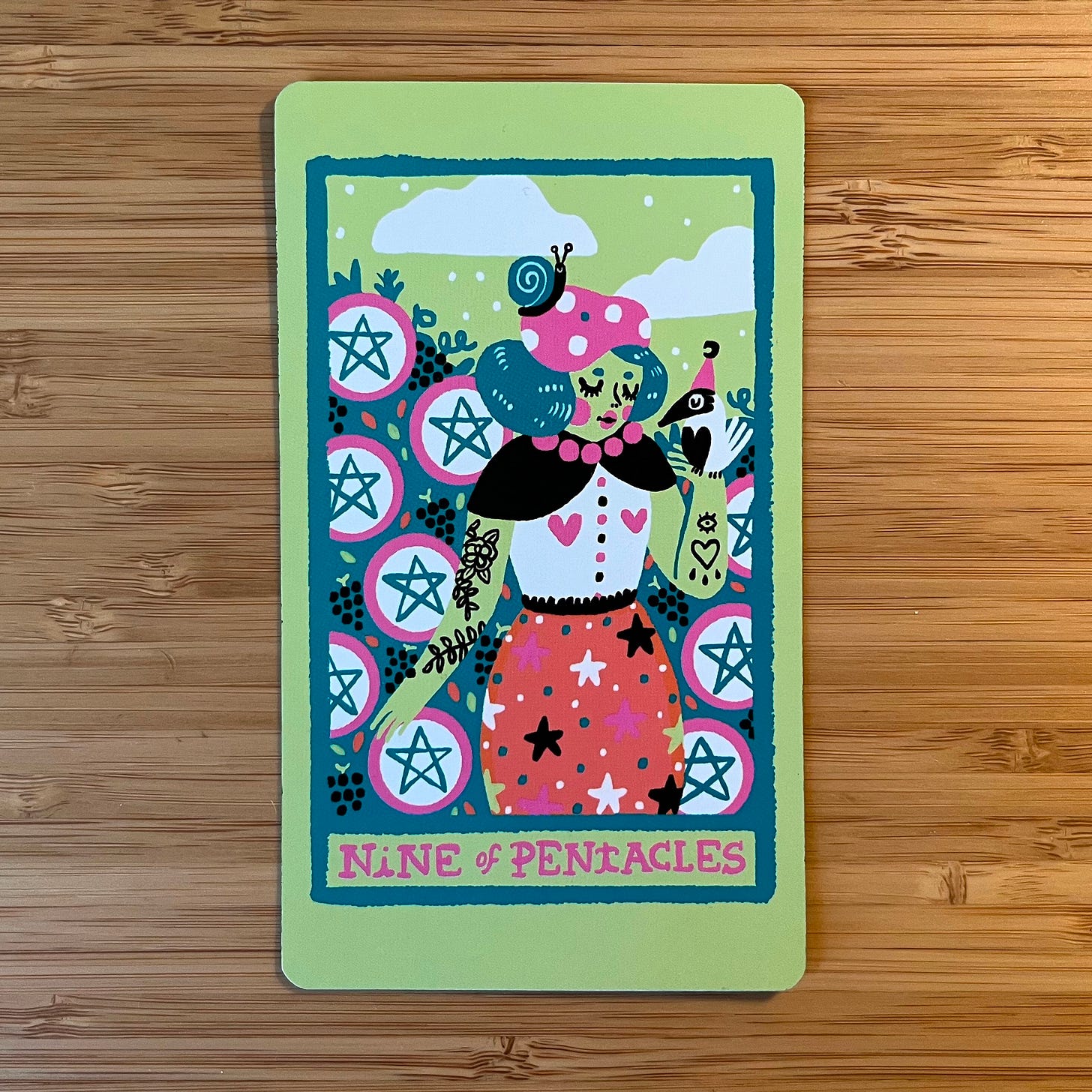What what will it take to do the "next right thing"?
I’ve been working through some big decisions this summer where the context felt so emergent that it was hard to figure out the “right” path forward. Which is to say: I’ve been grappling with feeling stuck.
Thankfully, I (eventually) remembered that while complexity can make it impossible to map a clear path to a goal… you can still know where you are, pick a direction (aka line of sight), and map your possible next steps. In other words, you can implement what complexity theorist Dave Snowden of Cynefin has dubbed the Frozen II strategy (yes, that Frozen II):
“All I can do is the next right thing; such small movements, at scale, create momentum for change, but with a commitment to the direction of travel, not to goals.”1
This is what inspired my August inquiry question:
What will it take to do the “next right thing”?
And the tarot card I pulled to kick off my reflection was the Nine of Pentacles:

Traditionally, the Nine of Pentacles represents resourcefulness, self-discipline, motivation, independence. In Tarot for Change Jessica Dore also writes that it speaks to “the particular type of liberation that comes with knowing that no matter what might be unfolding, we can choose to allow that which we have no control over — including our own unwanted thoughts and feelings — to arise.” And in Radical Tarot, Charlie Claire Burgess reflects:
“There’s also an adultness about [this card], the kind of self-knowledge and self-control that only comes of experience. The Nine of Pentacles highlights our ability to run our own lives by our own devices. This life is ours to build and no one else’s, a fact that comes with great freedom but also responsibility.”
Resourcefulness. Choice. Freedom. Responsibility. To put this energy into practice, this month I turned to the following resources…
1. The How To Decide Deck: Reframing “Good” Decisions as Processes (Not Products)
Described as a tool for “when you want to move forward but don’t know which direction to go in,” the How To Decide deck was created by People I've Loved and Annie Duke. I bought a copy last year but haven’t been able to spend much time with it until now. The cards are organized into five themes/strategies that support decision-making — Know Your Values, Learn From Your Past, Thought-Experiments, Imagine Possible Futures, and Take Comfort — and each contains an exercise or reflection question. There’s also a handful of cards that feature illustrations you might want to display on your desk as visual reminders.
I randomly pulled a few cards and worked through the prompts to help me strengthen my “line of sight.” However, my most powerful takeaway came from the experience of flipping through the deck and being reminded that decisions are journeys, not destinations. This led me to reframe a “good decision” as a quality process — vs. a right/wrong choice — which diffused a lot of the pressure I was feeling to guarantee a good outcome.
2. The Cognitive Bias Codex: Double-Checking for Bias
The Cognitive Bias Codex is an educational infographic created by Buster Benson and John Manoogian III that illustrates 188 cognitive biases. I keep a framed copy hanging on the wall next to my desk as a visual reminder that our brains’ reflexes can sometimes lead us astray.
It was a split second, but glancing up at this image made me question a big decision my family was about to make. I decided to methodically analyze all the information I’d gathered to inform the decision (to be fair, I work in evaluation!)… and, while neither of the choices we were weighing were bad choices, one was clearly stronger. And — surprise! — it wasn’t the one we’d been about to make. We‘d fallen prey to several of the “Too Much Information” and “Need to Act Fast” biases.
3. Co-Active’s “Balance” Coaching Principle: Owning Our Power To Act
The Co-Active coaching model I trained in is grounded in three core principles: “Fulfillment” (connection to what matters), “Balance” (conscious choice), and “Process” (working with emotion). Feelings of stuckness and powerlessness often go hand in hand. The “Balance” principle is all about getting unstuck and owning our power to act. It invites us to explore different perspectives, own the choices available to us, strategize where to focus our attention — and then commit, and act.
Building on the “Frozen II strategy” from the start of this post, this month I turned to Balance coaching to ground myself in the immediate and ask:
What perspectives are available to me right now — and what assumptions are driving them?
What actions are possible?
What do I choose?
As we near summer’s end, life still feels highly emergent, and the future uncertain — but at least the next right thing has become clear.



